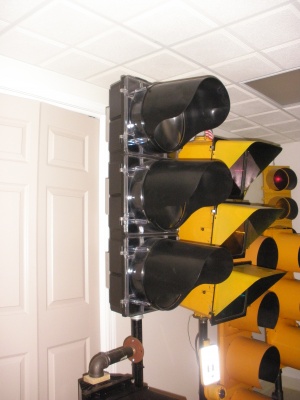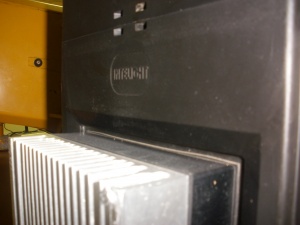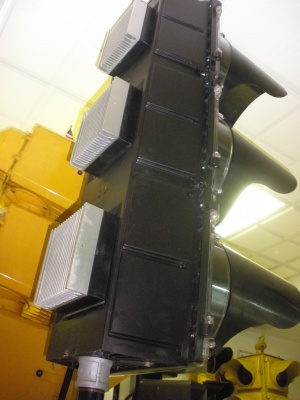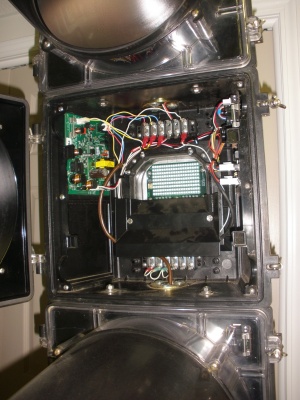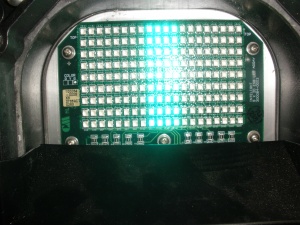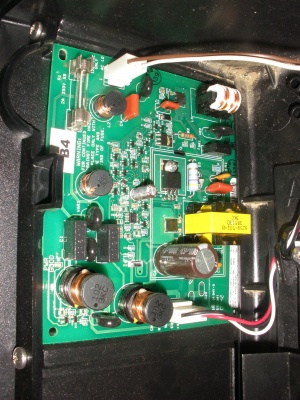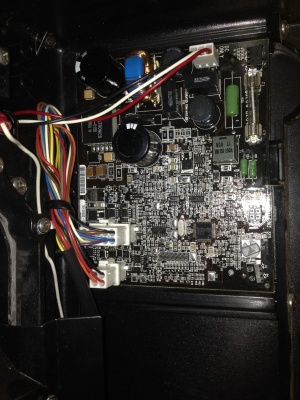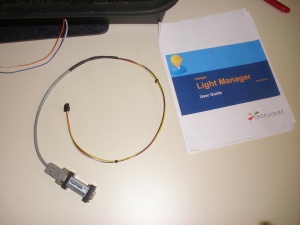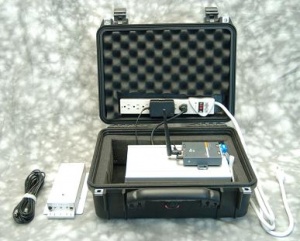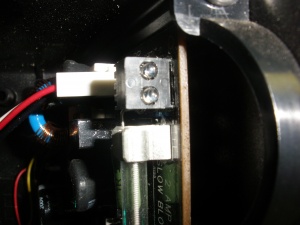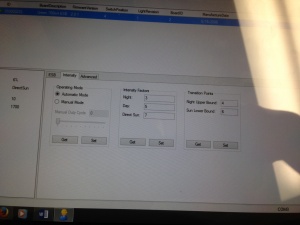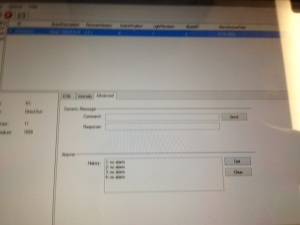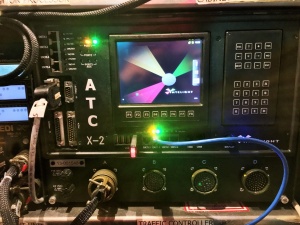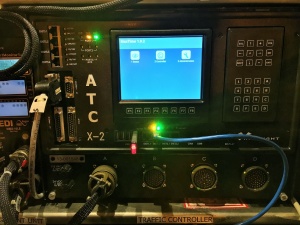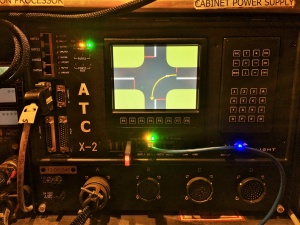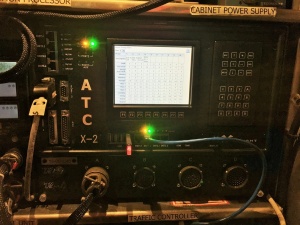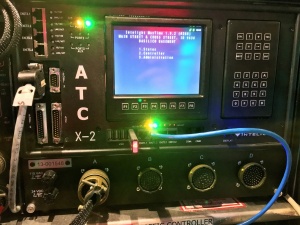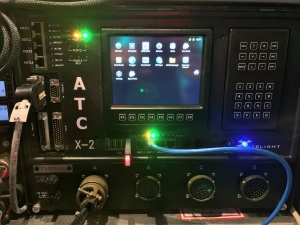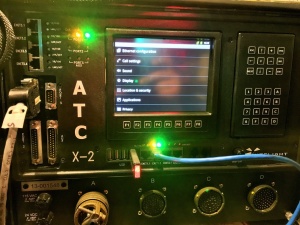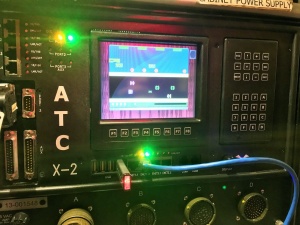Intelight
Contents
ESB Traffic Signal
Intelight’s flagship traffic signal product is their Electronically Steerable Beam (ESB) programmable visibility signal head. Essentially a modified version of the Optisoft vehicle signal, the Intelight model is advertised to compete with legacy incandescent programmable vehicle heads such as those made by 3M and McCain.
Physical Features
The ESB uses a Fresnel diffusing lens with a bank of LEDs (herein known as the “array”) behind to provide the illumination of the indication. The array has 9 rows and 20 columns of a single color of LED per section. The array circuit board is mounted directly to an aluminum heat sink to dissipate heat to outside the signal, improving the life of the electronics in the signal.
The housing is made of flame retardant Makrolon 9417, a type of high-grade polycarbonate, and available in the standard traffic signal colors. The housing is designed to be roomy, and house various electronics for a variety of options. Each section has four molded bosses where circuit boards could be installed.
The door is a one piece molded part, which eliminates the need for a lens gasket. The door is molded transparent and everything is blanked out, excluding the dome and ambient sensor window, with a molded plastic backing held in with the lens hardware
The lens is a milky, clear Fresnel, “diffuser” type that sits immediately behind the clear outer dome of the one-piece door. The lens is designed to disperse light across the entire dome, while not allowing any individual LED points be visible from the roadway. Intelight also offers a colored lens option in place of the standard clear lens.
The interior of each section of the ESB typically houses two main circuit boards in addition to the array for standard operation: a power filter circuit board, and a CPU controller board.
The power filter board does exactly that, it filters in power from the field to turn the LED array on at low voltage. It operates at both 120 volt AC and 48 volt DC power sources, and will indicate on the board that it is receiving power and operating properly.
The CPU controller board (herein as the CPU board) acts as the brain for the section. It handles the electronic steering of the light, ambient light adjustment, and stores general information about the section it controls. All of which can be accessed remotely using Intelight’s programming kits and software.
Standard Operation
The main selling feature of this signal is its ability to be programmed electronically, without tape, and in half the time compared to legacy programmable heads. Light steering can be done in the horizontal and vertical directions by effectively shutting off rows and columns of LEDs in the array, narrowing the light beam. Steering is achieved using either the wireless kit, or a serial interface kit. Both kits use Intelight’s Windows based interface software, "Light Manager". Light Manager comes in two main configurations: a laptop/tablet version, and mobile smartphone version.
When then array in a particular section is lit, the CPU board is recording general information about the light and the electronics. This is indicated by a flashing green indicator on the CPU. This data can be accessed by Light Manager when registering the signal at the time the array is on. Light Manager can only see and access the section when the light in that section is on.
Electronic Steering and Kits
As stated, two configurations are available to interface with the ESB. The more common version is the wireless kit, which uses a radio that is connected to a special load switch and talks over WIFI to the modem in the signal head. Once the radio equipment and load switch are set up, the technician simply stands where the masking point will be and select it via smart phone. This special load switch is only used to program, and once set can be replaced with a standard load switch. The other version is not typically used for field steering, but is available for shop environments and similar instances. It is the serial kit, which interfaces directly between the CPU board and a laptop or tablet.
When the light is on and has been registered in order to exchange data with Light Manager, the screen will display all the general information about the light including numeric ID, color, current, and manufacture date. The software can then access the current array configuration and it can be adjusted in real time in two row, or two column increments.
The software can only change or update the signal when the light is on, and has been registered in the software. When the light is off the software no longer can access the information but the software knows there is a registered array out there. This poses a problem with steering the yellow section. There are two ways to overcome this issue: one is to place the intersection in stop time to gain a few extra minutes to fine tune the yellows, or two, use the manual set feature in Light Manager so that changes are not completed in real time. The registered array can be set up while the light is not active, then immediately when the light comes on, send all the changed data manually.
Ambient Light Adjustment
The ESB also incorporates an infrared sensor, placed behind a window in the door, which automatically adjusts the intensity of the LEDs based on outside conditions. This sensor differs from those used in 3M or McCain heads, as it is logic based, with three internal levels: day, night, and direct sun, to a numeric value. When the CPU sees the values within a certain range, it will translate that info into a setting level.
The sensor is active by default, but can be disabled in Light Manager. Values for the different level setting can be adjusted, and there is an option to manually select an intensity level from 0 (off), to 100 (full power)
Other Features
In addition to all the features mentioned, the ESB also stores alarm information at the time the light is on. These alarms can also be accessed through Light Manager, and typically come up if there are issues with the electronics, or if the LED array is failing. If everything is operating properly, accessing the alarms from the signal will simply show “NO ALARM” from the screen. Up to four alarm conditions can be stored per section.
Intelight offers a built in video camera and electronics package that can be installed in the head for traffic surveillance. This feature is largely a carry over from the Optisoft days and is typically not selected. The camera installs in the lower left hand corner of the door, where another window must be punched out for it.
The other homeland security sensor options from Optisoft have largely been discontinued in one way or another.
Misc. Information
These are rough time ranges highlighting major changes and/or modifications of the ESB signal. This list was compiled based on actual conversation with Intelight reps as well as some information from their site.
2010-2013: Production/molding of the critical parts was moved to China as part of their "joint venture" with another company. Assembly was done in China and in Arizona. The newer signals did not have enough conformal coating on the boards, the housings had leaking issues and the lenses did not properly steer light as designed.
2013-2014: Intelight redesigned the wireless programming kit after the Lantronix radio equipment used in it was discontinued by the supplier. Warranty was reduced from 7 years to 3.
2014: the built in video camera option grandfathered in from Optisoft is no longer offered as an option.
2015: Intelight discontinued the electronically steerable beam signal to move forward with the controller and software markets.
Intelight Traffic Controllers
X Series
X1 Series Traffic Controller
This is Intelight's first NEMA oriented controller unit. It is a non-touch screen version and is their most popular used in the field. It runs their local traffic signal controller software "MaxTime" . It can also run with "MaxView" their central control software, and "MaxAdapt", their adaptive software package. More information to come at a later date.
X2 Series Traffic Controller
The X2, along with X1, controller is Intelight's flagship controller. It is the first traffic signal controller on the market with a full color, touch screen interface powered by Google Android. It is the first controller on the market to incorporate mobile technology outside of laptops. The controller is accessible from any standard web browser, including tablets and phones due to its onboard web server. The standard traffic signal software packages that Intelight provide can be installed on the controller. The local traffic signal controller software package is MaxTime. The X2 controller is powered on Android and retains many functions common on an Android driven cell phone.
X2 Traffic Control Touch Version
The primary function of the X2 controller is it's touchscreen version of MaxTime. It provides all the functions of MaxTime in a color, graphical user interface. The controller can display a real-time intersection diagram and uses the on-screen Android keyboard to program the unit coupled with the physical keyboard. Like a phone, the user can swipe, hover, and touch the screen to access, scroll, and pop up help windows. The controller allows the retaining and backup of the programming database on USB flash drive. This can also be used to transfer programs to another X2 controller. The time and date can be programmed manually or via GPS, where equipped.
X2 Traffic Control "Classic" Version
This version of MaxTime is also installed on the X2 controllers, and is the primary version installed on X1 and X1L Intelight controllers. There are no graphical functions, and the screen is not a touch version. Other than that, the core functions of MaxTime are all included.
The App Drawer / Android Functionality
The X2 includes a built in App Menu called the "App Drawer"
The App Drawer allows the user to download any Android app that is within the memory allowance/processing power of the controller unit. Android APK files can be downloaded via flash drive to the controller. Several standard apps come preloaded to the controller, including a working calculator, web browser, downloads folder, and touch calibrator.
The controller brain is built on the same one used in Android phones. This means some of the standard loaded applications do not operate as intended, such as the camera. Some applications and functions open but do not operate, others will crash upon opening.
Having the Android backbone to the controller opens the doors for developers to produce app driven traffic software packages, limiting the amount of proprietary equipment in the cabinet. The X2 is capable of streaming video from IP driven video detection cameras eliminated the need for separate video monitors in the cabinet. Of course, the ability to download and use standard .APK android files allows for non-conventional apps to run including games. As long as the file is not too large, it will run. It is not designed to run games, and certain games will not load properly, or load flipped awaiting the user to turn the screen like a phone.
No matter what app is running in the app drawer, MaxTime is always functioning and cannot be stopped. This means traffic operation remains active no matter what is running simultaneously with it.
Web Server and Remote Functions
The controller can be given an IP address and accessed on a LAN via onboard web server. When connected, the user can access the controller, or multiple controllers from a standard web browser. The web version is called the "MaxTime Database Editor" which runs in a Windows version or mobile version similar to the MaxTime touch interface. The web version has an integrated MaxTime programming manual and ability to print reports out using any PC printer. **Photos of the remote functions to come at later date**
X3 Series Traffic Controller
This is Intelight's latest addition to the X-series line. Faster processing speed, smaller controller physically, and comes in both a 2070 and a NEMA version. The X3 also has a larger touch screen interface and runs on Google Android. It runs all Intelight software packages and Android applications similar to the X2. More information to come at a later date.
X1L Series Traffic Controller
This controller a cheaper version of the X1 controller. It is the X1 Lite or X1L. It includes all the basic functions of the X1 controller without all the "fluff" Less ports and power on this controller, it is designed for the budget-conscious municipality. Still runs all standard Intelight software packages, but like X1, is not powered on an Android brain. More information to come at a later date.
2070 Series Traffic Controllers
There are several models equipped for 2070 operation, both standard 2070L, and Android touch versions. More to come at a later date.
MaxTime
MaxTime is the local intersection controller software installed on all Intelight NEMA traffic controllers. It is one of many packages that can be installed on Intelight 2070 controllers. It can handle up to 50 phases of control and allows for great flexibility for unique applications, built in coordinator, scheduler, pre-emption and prioritor functions. The detector functionality is also advanced and flexible for alot of standard and non-standard detectors as well as the ability to provide data reports. On Android powered Intelight controllers, MaxTime is an always operation application regardless of the controller front panel, or any other applications running. MaxTime can be accessed remotely from any web browser. This allows for remote programming using a mobile interface.
